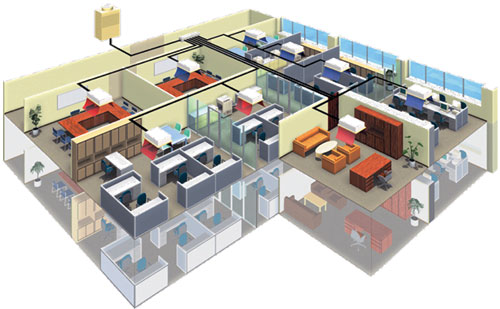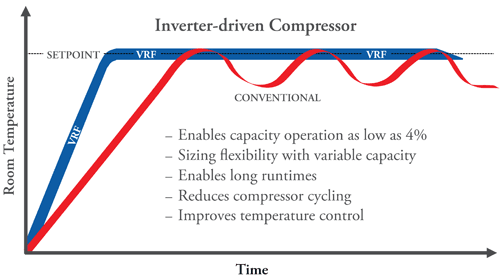Cool VRF Technology
The most common types of HVAC equipment are unitary air conditioners and heat pumps. "Unitary" refers to the fact that all of the components necessary to heat, cool, dehumidify, filter and move air are included in one or more factory-made assemblies. "Heat pumps" refer to an air-conditioning system that is capable of reversing the direction of refrigerant flow to provide either cooling or heating to the indoor space.
Light commercial and residential HVAC types include packaged terminal air-conditioning units (PTACs), unitary units, window units, wall-mounted units, radiant heaters and ductless systems.
For large commercial and industrial applications, HVAC options fall under one of three categories:
Packaged Systems: The HVAC system is contained in one unit. This type of HVAC system can include traditional boilers, chillers, water-source heat pumps and multi-zone rooftop units–basically any system that is based on water or direct expansion (DX). Typically, conditioned air is ducted from the system to the indoor space through ducts.
Split Systems: The system has two parts, usually an indoor air-handling unit and outdoor unit housing the compressor. Again, the components of this system can include boilers, chillers and water source heat pumps, etc. A split ductless system is comprised of a remote outdoor condensing unit connected by refrigerant pipes to a matching, non-ducted indoor air handler. Special cases for introducing fresh air may call for limited ducting to the air handler from outside.
VRF Systems: A flexible version of both of the more traditional options, with the key difference being that VRF reacts to changes in cooling and heating requirements by varying the flow of refrigerant to individual zones as opposed to moving cooled or heated air through ductwork to those spaces.
 |
VRF systems include a central variable capacity outdoor unit connected to multiple variable capacity indoor units. Photo courtesy of Mitsubishi Electric |
What is Variable Refrigerant Flow?
Variable Refrigerant Flow (VRF) technology is an energy-efficient method of providing precise comfort control to indoor environments. Varying the refrigerant flow to each zone or indoor unit servicing that zone allows the system to constantly monitor and control the amount of cooling or heating that is being delivered through each unit. This allows the temperature of that area to be more precisely controlled.
By utilizing a branch circuit controller, the system can simultaneously cool some zones while heating other areas, thus providing the ultimate in zoned comfort. (Zones are single or multiple room spaces that are conditioned to a set temperature and are operated independently from other rooms within the same structure.)
Inverter-driven compressor
VRF technology is accomplished through the use of an inverter-driven (variable speed) compressor housed in the outdoor unit, which responds to indoor temperature changes. Because an inverter compressor can vary its motor rotation speed and capacity and the indoor units can vary their capacity, the system delivers the capacity to precisely meet the load in each zone. Power consumption is therefore reduced because the system operates only at the levels needed to maintain a constant and comfortable indoor environment.
 |
Exposed VRF system for a café demonstrates flexibility of placement and installation. Photo courtesy of Mitsubishi Electric |
Inverter compressor technology is highly responsive and efficient. The technology allows for compact, quiet units; flexibility of placement; and gives architects and owners more design freedom with integrated, simple to use controls.
A typical system is made up of a central variable capacity outdoor unit connected to as many as 50 variable capacity indoor units.
Inverter technology can be compared to an automobile's cruise control. Just as the driver sets the velocity in a car, the facility manager or building occupant determines the temperature setpoint. The cruise control works to maintain the car's velocity as it goes up and down hills and around curves. Similarly, inverter compressors ramp up to achieve the desired setpoint. Once the setpoint has been achieved, the indoor units operate with long runs at a low level in order to maintain the temperature setpoint. Conversely, traditional HVAC systems use more energy to maintain the temperature setpoint because of short cycling or from the need to turn the compressor fully off and on. This use demands the maximum energy output each time the system starts.
Energy can be lost in other ways in traditional ducted systems. Moving air throughout a building requires long runs of ductwork and the use of larger fan motors to move the air. This wastes a significant amount of energy when compared with a VRF system, which moves refrigerant to the indoor unit–the unit is either inside or in close proximity to the space–and then uses a small fan motor to move air.
 |
Inverter-driven compressors maintain room temperatures at a steady setpoint. Chart courtesy of Mitsubishi Electric |
Part-Load Operations As of January 1, 2010, the Air Conditioning, Heating and Refrigeration Institute (AHRI) has established a new procedure yielding an Integrated Energy Efficiency Ratio (IEER) rating. This is a great improvement over the unitary-only IPLV (Integrated Part Load Value) method because it covers all units even if they are single stage. To obtain IEER ratings, the systems are tested at four different capacity levels and outdoor temperature conditions to provide a very accurate part-load measure. IEER should be the gold standard for part-load systems in the near future. Those manufacturers of VRF systems with inverter technology are well positioned to achieve high IEER ratings. |









